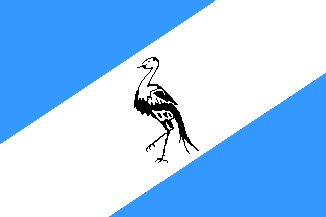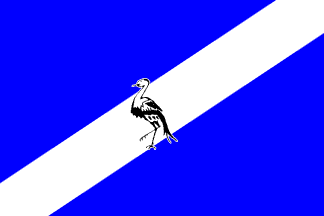
This page is part of © FOTW Flags Of The World website
Ciskei (South African homeland)
Last modified: 2005-08-26 by bruce berry
Keywords: south africa | homeland | ciskei | bird: crane | indwe |
Links: FOTW homepage |
search |
disclaimer and copyright |
write us |
mirrors
 by Mark Sensen, 01 December 1998
by Mark Sensen, 01 December 1998
See also:
Ciskei - introduction
Within the "old" South Africa, 10 homelands were created, four of which
were granted "independence" by South Africa (not recognised by any other
country in the world). These former South African Homelands/bantustans
ceased to exist on 27 April 1994. They have all (including the former so
called independent Homelands) been reincorporated into South Africa.
The flags of the former Homelands are no longer in use (either officially
or unofficially).
Bruce Berry, 25 April 1996
Ciskei was the largest unsegmented bantustan, in south eastern Cape
Province (currently Eastern Cape).
Antonio Martins, 30 May 1999
Ciskei flag description
The design of the Ciskei flag was originally set out in section 2 of
the Ciskei Flag Act of 1977 which reads as follows:
"The flag of the Ciskei shall be blue with a bend sinister of white,
over all a Blue Crane proper edged white (sic).
The width of the flag shall be equal to two-thirds of its length.
The width of the bend sinister shall be one-sixth of the length of
the flag.
The height of the Blue Crane shall be one-third of the width of the
flag".
The blue in the flag is said to symbolise the infinity of the sky and
the striving for progress and development. The white bar refers to the
path which must be followed in order to bring this development to fruition.
The Blue Crane or "Indwe" is symbolises the desire of the Xhosa people
to be courageous and steadfast and to labour with diligence for the future
of the country and its people. Traditionally those who distinguished themselves
were decorated with feathers of the Blue Crane by the tribal Chief.
Although the official description gives the colours of the "indwe"
as proper, that is in its natural colours, in practise the blue crane was
depicted on the flag in black outline and with black detail.
This flag was officially taken into use on 22 June 1977 although it
had in fact first been hoisted outside the Legislative Assembly building
on 15 March 1974.
Ciskei was granted internal self-government on 1 August 1972 and achieved
full "independence" from South Africa on 4 December 1981. A description
of this flag was incorporated into Schedule 3 of the Republic of Ciskei
Constitution Act.
Ciskei was re-incorporated into South Africa on 27 April 1994 and ceased
to exist as a separate political entity and the flag is no longer in use.
The image above shows the design of the Ciskei flag actually used although
this is slightly different from that which is described in the Flag Act.
The design as officially described is as shown below.
Bruce Berry, 1 December 1998
I made the image based on what is depicted in the following books:
-
"Flags of the world", Barraclough, 1981. ([bcr81])
-
"Alverdens flag i farver", Pedersen, 1979. ([ped79a])
-
"Flags and arms across the world", Smith, 1980. ([smi80])
-
"Prisma vlaggenboek", Poels, 1990. ([poe90])
-
"Sovereign flags of Southern Africa", Burgers, 1997. ([bur97])
In these books the white stripe is much wider, so the crane fits in it.
OTOH, in this way the description makes sense when it says "...edged
white" and "...over all...", which doesn't make sense when the crane fits
in the stripe.
Mark Sensen, 1 December 1998
Flag of Ciskei seems to be according official description, never used.
The bird must be a bit in the blue parts.
Jaume Ollé, 12 Apr 2001
Ciskei's Coat of Arms can be seen on
Mike
Oettle's pages. (ed.)
Ciskei - variant according to official specifications
 by Mark Sensen, 1 December 1998
by Mark Sensen, 1 December 1998
 by Mark Sensen, 01 December 1998
by Mark Sensen, 01 December 1998

 by Mark Sensen, 01 December 1998
by Mark Sensen, 01 December 1998
 by Mark Sensen, 1 December 1998
by Mark Sensen, 1 December 1998